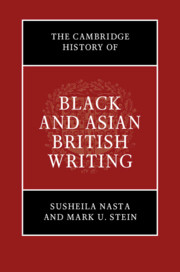Book contents
- The Cambridge History of Black and Asian British Writing
- The Cambridge History of Black and Asian British Writing
- Copyright page
- Dedication
- Contents
- Notes on Contributors
- Preface and Acknowledgements
- Introduction
- Part I New Formations
- Part II Uneven Histories
- (I) Global Locals
- (II) Disappointed Citizens
- 12 Looking Back, Looking Forward
- 13 Double Displacements, Diasporic Attachments
- 14 Wide-Angled Modernities and Alternative Metropolitan Imaginaries
- 15 Forging Collective Identities
- 16 Breaking New Ground
- 17 The Lure of Postwar London
- 18 Looking Beyond, Shifting the Gaze
- (III) Here to Stay
- Part III Writing the Contemporary
- Select Bibliography
- Index
15 - Forging Collective Identities
The Caribbean Artists Movement and the Emergence of Black Britain
from (II) - Disappointed Citizens
Published online by Cambridge University Press: 19 December 2019
- The Cambridge History of Black and Asian British Writing
- The Cambridge History of Black and Asian British Writing
- Copyright page
- Dedication
- Contents
- Notes on Contributors
- Preface and Acknowledgements
- Introduction
- Part I New Formations
- Part II Uneven Histories
- (I) Global Locals
- (II) Disappointed Citizens
- 12 Looking Back, Looking Forward
- 13 Double Displacements, Diasporic Attachments
- 14 Wide-Angled Modernities and Alternative Metropolitan Imaginaries
- 15 Forging Collective Identities
- 16 Breaking New Ground
- 17 The Lure of Postwar London
- 18 Looking Beyond, Shifting the Gaze
- (III) Here to Stay
- Part III Writing the Contemporary
- Select Bibliography
- Index
Summary
Co-founders Edward Kamau Brathwaite, John La Rose, and Andrew Salkey envisaged the Caribbean Artists Movement (CAM) as a forum for engaging with the work of Caribbean writers and artists in the UK, and for stimulating interest among British people. While well-established writers and artists including C. L. R. James, Wilson Harris, and Aubrey Williams were involved from the outset, younger writers and artists followed later. Although CAM existed formally only for six years (1966–1972), public symposia, conferences, as well as its newsletter and periodical ensured CAM was pivotal in defining Caribbean and black British aesthetics. It operated within and at times strained against the institutions that shaped the politics of cultural life in Britain. CAM anticipated and contributed to the forging of black British self-representation and collective identity, exemplifying processes that were anchored in frameworks of black Atlantic radicalism, and, in many cases, in a revolutionary politics of solidarity. It contributed significantly to the growth of alliances which cut across cultural, ethnic, and geographical divides, influencing cultural theorists like Stuart Hall and Paul Gilroy.
Keywords
- Type
- Chapter
- Information
- The Cambridge History of Black and Asian British Writing , pp. 246 - 262Publisher: Cambridge University PressPrint publication year: 2020

